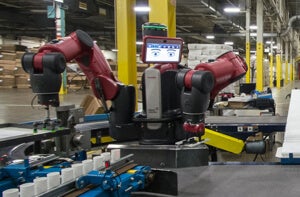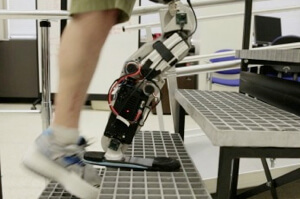This article co-written with Ken Goffman.
One of the things that happens when you write books about the future is you get to watch your predictions fail. This is nothing new, of course, but what’s different this time around is the direction of those failures.
Used to be, folks were way too bullish about technology and way too optimistic with their predictions. Flying cars and Mars missions being two classic—they should be here by now—examples. The Jetsons being another.
But today, the exact opposite is happening.
Take Abundance. In 2011, when Peter Diamandis and I were writing that book, we were somewhat cautious with our vision for robotics, arguing that we were still ten to fifteen years away from a major shift.
And we were wrong.
Just three years later, Google went on a buying spree, purchasing eight different robotics companies in less than six months, Amazon decided it was time to get into the drone delivery (aka flying robots) business, and Rethink Robotics released Baxter (a story explored in my new release Bold), the first user-friendly industrial robot to hit the market.

Baxter was the final straw. With a price tag of just $22,000 and a user-friendly interface a child could operate, this robot is already making the type of impact we were certain would show up around 2025.
And we’re not the only ones having this experience.
Earlier this year, Ken Goffman—aka RU Sirius—the founder of that original cyberpunk journal Mondo 2000 and longtime science, technology and culture author—published Transcendence, a fantastic compendium on transformative technology. Goffman has spent nearly 40 years working on the cutting edge of the cutting edge and is arguably one of a handful of people on the planet whose futurist credentials are truly unassailable—yet he too found himself way too conservative with his futurism.
You really have to stop and think about this for a moment. For the first time in history, the world’s leading experts on accelerating technology are consistently finding themselves too conservative in their predictions about the future of that technology.
This is more than a little peculiar. It tells us that the accelerating change we’re seeing in the world is itself accelerating. And this tells us something deep and wild and important about the future that’s coming for us.
So important, in fact, that I asked Ken to write up his experience with this phenomenon. In his always lucid and always funny own words, here’s his take on the dizzying vertigo that is tomorrow showing up today:
In the early ‘90s, the great science fiction author William Gibson famously remarked, “The future is here. It’s just not very evenly distributed.” While this was a lovely bit of phraseology, it may have been a bit glib at the time. Nanotechnology was not even a commercial industry yet. The hype around virtual reality went bust. There were no seriously funded brain emulation projects pointing towards the eventuality of artificial general intelligence (now there are several). There were no longevity projects funded by major corporations (now we have the Google-funded Calico). You couldn’t play computer games with your brain. People weren’t winning track meets and mountain climbing on their prosthetic legs. Hell, you couldn’t even talk to your cell phone, if you were among the relatively few who had one.

Over the last few years, the tantalizing promises of radical technological changes that can alter humans and their circumstances have really started to come into their own. Truly, the future is now actually here, but still largely undistributed (never mind, evenly distributed).
During the process of writing and editing (with Jay Cornell) a book about these types of advances, I got to experience the head spinning vertiginous nature of technological and scientific acceleration.
The book, Transcendence: The Disinformation Encyclopedia of Transhumanism and the Singularity, was written primarily in 2013 and released at the start of this year. In the between-time, astonishing, mind blowing things occurred in many of the areas we wrote about. In at least one case, cryonics, we were very skeptical while writing about it. But the future started to get weirder behind our backs.
Here are just a few of the things that hit the news in 2014 and thus far in 2015 that bode well for a strange, interesting and promising near future.
• Cryonics: Doctors at UPMC Presbyterian Hospital in Pittsburgh will place ten patients with life-threatening gunshot or knife wounds in a sort of suspended animation, theoretically allowing them more time to fix the injuries. They won’t quite be raising the dead through science, but if this work succeeds, cryonics will have to be taken very seriously as an alternative to dying.
• Nanobots in the human body: This year, nanotech scientists working in Israel announced a trial of nanobots to fight cancer. As the website Next Big Future exclaimed, “This is the development of the vision of nanomedicine. This is the realization of the power of DNA nanotechnology. This is programmable DNA nanotechnology.”
Nanotech enthusiasts have long treasured the hope that molecular “robots” — i.e., nanobots — could be designed to enter the body and eat plaque, kill cancerous cells, repair damaged tissue and, in general, act like a team of minuscule crack repairmen (or repairpersons, if you prefer) fixing anything that starts to go wrong before it can create much damage. This year marks a first really big hopeful step towards that potentially healthy and long-lived future.
• 3D printed organs: Organovo used a 3D printer to make liver tissue. Fully printed replacement organs are only a matter of time. If nanotech can’t keep your organs young, print a new one.
• Reversing aging: Harvard Researchers have discovered a chemical that can actually reverse aging cells in mice. We continue to gather evidence that aging can be slowed, stopped and now reversed in living creatures, including mammals. We work our way up the food chain towards our selves.
• Brain enhancement: Researchers at Duke University found a type of neuron that can tell stem cells to make more new neurons. The scientists involved actually point to intelligence increase as a goal of their project, saying that they hope that they will find ways to “engage certain circuits of the brain to lead to a hardware upgrade.”
More brain enhancement: In the area of optogenetics and neuroscience, researchers successfully manipulated brain activity with pulses of laser light.
• Still more brain enhancement: DARPA announced a four year plan to create a brain implant that can restore memories. As Cornell and I noted in our book, we are on the cusp of technologies that can preserve memories, erase memories and, on a more frightening note, implant memories. DARPA also has a five-year program to create a brain implant that can fight mental disorders. Again, the ambiguity of allowing the army to alter your brain must be noted, but given the suffering caused by mental illness, this would seem, in balance, to be a good thing
We live in a time when the announcement of a transgender man giving birth (it happened) or a system that shows images of your thoughts and dreams on a screen (it happened in 2008) barely rates a blip and a raised eyebrow amidst the deluge of news items related to science, or global troubles, or Kim Kardashian’s rear parts. But what William Gibson said is now true. The future is here. It’s just not (evenly) distributed yet.”
The speed of change can sometimes be overwhelming. At the same time, the time lag between the tantalizing possibilities of things like nanobots in the bloodstream or longevity treatments, and their actual functional availability, can be frustrating. It’s up to each of us to stay as informed and as engaged as we can so that we can individually and collectively shape how these things get done and how they get used.
*For similar content, sign up for Steven’s email newsletter here.
**If you’re interested in Ken Goffman’s Transcendence, check it out here.
Image Credit: Shutterstock.com; Rethink Robotics; Rehabilitation Institute of Chicago



